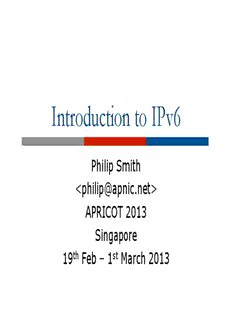
Introduction to IPv6 PDF
Preview Introduction to IPv6
Introduction to IPv6 Philip Smith <[email protected]> APRICOT 2013 Singapore 19th Feb – 1st March 2013 Presentation Slides Will be available on p http://thyme.apnic.net/ftp/seminars/ n APRICOT2013-IPv6-Introduction.pdf And on the APRICOT2013 website n Feel free to ask questions any time p Agenda Background p Protocols & Standards p Addressing p Routing Protocols p Integration & Transition p Early Internet History Late 1980s p Exponential growth of the Internet n Late 1990: CLNS proposed as IP replacement p 1991-1992 p Running out of “class-B” network numbers n Explosive growth of the “default-free” routing table n Eventual exhaustion of 32-bit address space n Two efforts – short-term vs. long-term p More at “The Long and Windy ROAD” n http://rms46.vlsm.org/1/42.html 4 Early Internet History CIDR and Supernetting proposed in 1992-3 p Deployment started in 1994 n IETF “ipng” solicitation – RFC1550, Dec 1993 p Proliferation of proposals: p TUBA – RFC1347, June 1992 n PIP – RFC1621, RFC1622, May 1994 n CATNIP – RFC1707, October 1994 n SIPP – RFC1710, October 1994 n NIMROD – RFC1753, December 1994 n ENCAPS – RFC1955, June 1996 n Direction and technical criteria for ipng choice – p RFC1719 and RFC1726, Dec 1994 5 Early Internet History → 1996 RFC1883 published in December 1995 p IPv6 Specification n Other activities included: p Development of NAT, PPP, DHCP,… n Some IPv4 address reclamation n The RIR system was introduced n p → Brakes were put on IPv4 address consumption IPv4 32 bit address = 4 billion hosts p HD Ratio (RFC3194) realistically limits IPv4 to 250 n million hosts 6 Recent Internet History “ ” The boom years → 2001 IPv6 Development in full swing p Rapid IPv4 consumption n IPv6 specifications sorted out n (Many) Transition mechanisms developed n 6bone p Experimental IPv6 backbone sitting on top of Internet n Participants from over 100 countries n Early adopters p Japan, Germany, France, UK,… n 7 Recent Internet History “ ” The bust years: 2001 → 2004 The DotCom “crash” p i.e. Internet became mainstream n IPv4: p Consumption slowed n Address space pressure “reduced” n Indifference p Early adopters surging onwards n Sceptics more sceptical n Yet more transition mechanisms developed n 8 2004 → 2011 Resurgence in demand for IPv4 address space p All IPv4 address space was allocated by IANA by 3rd n February 2011 Exhaustion predictions did range from wild to n conservative …but by early 2011 IANA had no more! n …and what about the market for address space? n Market for IPv4 addresses: p Creates barrier to entry n Condemns the less affluent to tyranny of NATs n IPv6 offers vast address space p The only compelling reason for IPv6 n 9 Current Situation General perception is that “IPv6 has not yet p taken hold” IPv4 Address run-out has now made it into “headline n news” More discussions and run-out plans proposed p Private sector still demanding a business case to n “migrate” No easy Return on Investment (RoI) computation p But reality is very different from perception! p Something needs to be done to sustain the Internet n growth IPv6 or NAT or both or something else? n 10
Description: